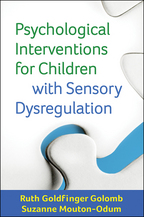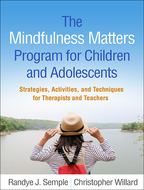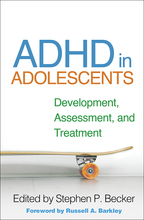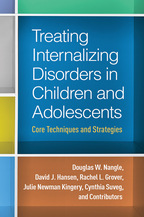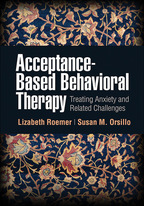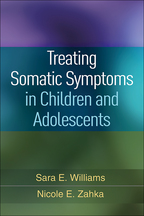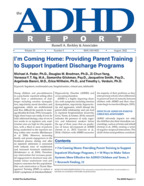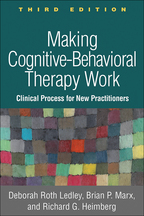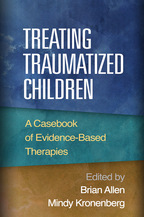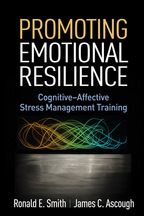Psychological Interventions for Children with Sensory Dysregulation
Ruth Goldfinger Golomb and Suzanne Mouton-Odum
Hardcovere-bookprint + e-book
Hardcover
orderAugust 2, 2016
ISBN 9781462527021
Price: $33.00 174 Pages
Size: 6" x 9"
The reproducible materials can be downloaded and printed in PDF format.
“Golomb and Mouton-Odum provide comprehensive guidelines for the process of identifying, assessing, and targeting sensory stimulus triggers and problematic behavior for therapeutic intervention. The authors draw on their substantial clinical expertise, knowledge, and research to describe the adverse impact of overresponsiveness, underresponsiveness, and sensation-seeking behavior on academic, social-emotional, and daily living skills in children. The text is an important source of information for psychologists, counselors, social workers, and occupational therapists, as well as students in these fields….The text would be an excellent addition to the library of mental health professionals working with children and adolescents.”

—PsycCRITIQUES
“A timely text on an issue of increasing relevance and awareness in the general public….Can be helpful for therapists dealing with children, adults, and families as it provides an additional layer of information which can be incorporated into assessment and then treatment.”

—Child and Family Behavior Therapy
“This thought-provoking book shows that when traditional CBT or medication management fails, it may be because a child's underlying sensory differences require a different perspective. Golomb and Mouton-Odum describe how to effectively combine CBT and sensory therapies. They utilize a balance of techniques—exposure, sensory intervention, coping skills, and counter-conditioning—to help children build better tolerance for sensory stimuli. All clinicians who work with children will benefit from this fresh integration of psychological and occupational therapy frameworks. The book is filled with practical strategies and helpful vignettes that are obviously harvested from years of clinical experience.”

—Daniel G. Shapiro, MD, developmental and behavioral pediatrician, Rockville, Maryland
“Sensory issues underlie many childhood anxieties. A kid may refuse certain foods or fear thunder because of sensory overload rather than irrational beliefs. When mental health professionals understand the possible physiological reasons for dysregulated behavior, they can help children succeed by using the smart intervention strategies presented in this important and readable book.”

—Carol S. Kranowitz, MA, author of The Out-of-Sync Child
“As a psychologist in practice for more than 30 years, I appreciate how this book highlights relevant factors to consider when treating children and teens with sensory modulation challenges, especially those who do not respond to traditional exposure therapy. Golomb and Mouton-Odum present real-world case examples of youth with over- or underreactive sensory systems. They propose a model to augment exposure therapy with additional elements to increase the success of treatment, and offer helpful checklists to guide questioning, specific outlines for creative exposures, and tips for comprehensive treatment planning. The book addresses an underexplored issue that is of direct relevance to clinicians working with children.”

—Mary Karapetian Alvord, PhD, Director, Alvord, Baker & Associates, Silver Spring and Rockville, Maryland
“A much-needed book that fills a void in our understanding of how sensory issues may affect children's feelings and behavior, leading to challenges in treatment. This book reflects the authors’ deep clinical expertise and provides pearls of wisdom that bring clarity to complexity, along with a systematic roadmap for assessment and treatment. Easy to read, and full of helpful examples, it is a reference that therapists will pick up often.”

—Aureen Pinto Wagner, PhD, Director, The Anxiety Wellness Center, Cary, North Carolina
—PsycCRITIQUES
“A timely text on an issue of increasing relevance and awareness in the general public….Can be helpful for therapists dealing with children, adults, and families as it provides an additional layer of information which can be incorporated into assessment and then treatment.”
—Child and Family Behavior Therapy
“This thought-provoking book shows that when traditional CBT or medication management fails, it may be because a child's underlying sensory differences require a different perspective. Golomb and Mouton-Odum describe how to effectively combine CBT and sensory therapies. They utilize a balance of techniques—exposure, sensory intervention, coping skills, and counter-conditioning—to help children build better tolerance for sensory stimuli. All clinicians who work with children will benefit from this fresh integration of psychological and occupational therapy frameworks. The book is filled with practical strategies and helpful vignettes that are obviously harvested from years of clinical experience.”
—Daniel G. Shapiro, MD, developmental and behavioral pediatrician, Rockville, Maryland
“Sensory issues underlie many childhood anxieties. A kid may refuse certain foods or fear thunder because of sensory overload rather than irrational beliefs. When mental health professionals understand the possible physiological reasons for dysregulated behavior, they can help children succeed by using the smart intervention strategies presented in this important and readable book.”
—Carol S. Kranowitz, MA, author of The Out-of-Sync Child
“As a psychologist in practice for more than 30 years, I appreciate how this book highlights relevant factors to consider when treating children and teens with sensory modulation challenges, especially those who do not respond to traditional exposure therapy. Golomb and Mouton-Odum present real-world case examples of youth with over- or underreactive sensory systems. They propose a model to augment exposure therapy with additional elements to increase the success of treatment, and offer helpful checklists to guide questioning, specific outlines for creative exposures, and tips for comprehensive treatment planning. The book addresses an underexplored issue that is of direct relevance to clinicians working with children.”
—Mary Karapetian Alvord, PhD, Director, Alvord, Baker & Associates, Silver Spring and Rockville, Maryland
“A much-needed book that fills a void in our understanding of how sensory issues may affect children's feelings and behavior, leading to challenges in treatment. This book reflects the authors’ deep clinical expertise and provides pearls of wisdom that bring clarity to complexity, along with a systematic roadmap for assessment and treatment. Easy to read, and full of helpful examples, it is a reference that therapists will pick up often.”
—Aureen Pinto Wagner, PhD, Director, The Anxiety Wellness Center, Cary, North Carolina

